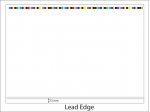Ryobi 662PFH.
pH 5, 850-900 mS.
Water t° 12-13°C.
IPA 12-14%.
Huber inks.
Prisco and Varn Supreme.
At the beginning of print (morning) its OK.
Water is 2.2-2.3 (Ryobi unit of measure).
Strip on lead edge of paper appears with increasing temperature in pressroom. (24-25°C and higher).
After 1-1,5 hours.
I add water (2.5-2.7) - the line disappears.
After 15-20 minutes is necessary to add more water (2.9-3.0).
And so...
In the evening water is 5.5-6.0.
And emulsified inks.
pH 5, 850-900 mS.
Water t° 12-13°C.
IPA 12-14%.
Huber inks.
Prisco and Varn Supreme.
At the beginning of print (morning) its OK.
Water is 2.2-2.3 (Ryobi unit of measure).
Strip on lead edge of paper appears with increasing temperature in pressroom. (24-25°C and higher).
After 1-1,5 hours.
I add water (2.5-2.7) - the line disappears.
After 15-20 minutes is necessary to add more water (2.9-3.0).
And so...
In the evening water is 5.5-6.0.
And emulsified inks.

















